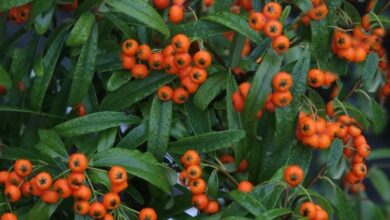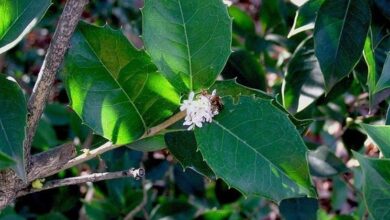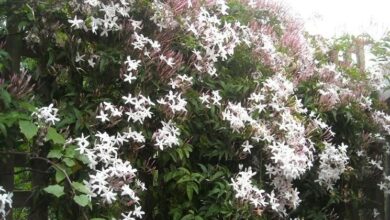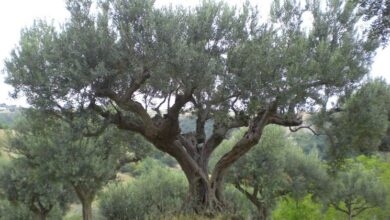Platanillo (Heliconia)

The heliconia are spectacular plants, flowers very, very alive that make anywhere look very cheerful. They are also very popular, especially in regions where the climate is warm, since their cultivation is quite simple.
As if that were not enough, they can be kept indoors with a lot of light, so if there are frosts in your area you will have the option of enjoying them anyway . Discover them.
Origin and characteristics
![]()
Heliconia ‘Golden Torch’
They are perennial and rhizomatous herbaceous plants native to the tropical regions of South America, Central America, the Pacific Islands and Indonesia, popularly called platanillo, bird of paradise (not to be confused with Strelitzia), lobster claw or simply heliconia. They can reach heights of up to 6 meters, with large, whole and petioled leaves, green in color.
What we know as flowers, are actually inflorescences formed by bracts (modified leaves that protect the flowers themselves) of colors such as red, yellow, orange, or bicolor.
Main species
The genus Heliconia is made up of about 100 species, the following being the most popular:
- Heliconia bihai: it is native to Central and South America. It reaches a maximum height of 3 meters, and produces red inflorescences.
- Heliconia rostrata: it is native to the tropical forests of Central and South America. It can reach a maximum height of three meters, with leaves of up to 1.20m. The inflorescences are hanging, 30 to 60cm, and red.
- Heliconia psittacorum: It is native to the Caribbean, as well as South America. It reaches a maximum height of two meters, and produces red-orange inflorescences.
What are their cares?
![]()
Heliconia latispatha
Would you like to have a copy? If so, we recommend that you provide the following care:
Location
- Exterior: it is important that it is in a bright area but without direct sunlight since otherwise it would burn.
- Interior: the room must be bright, without drafts, and with high humidity. The latter can be achieved by buying a humidifier or by placing containers with water around the plant.
Earth
- Garden: the soil must be rich in organic matter, well drained, and preferably somewhat acidic.
- Pot: mix 60% mulch (sold here ) with 30% perlite (get it here ) and 10% worm castings (you’ll find it here ).
Irrigation
Heliconia are plants that live in rainforests, so they don’t withstand drought. But also, it must be borne in mind that waterlogging does not do them well either, since if the earth were constantly wet during the winter, its roots would be greatly damaged.
Therefore, it is highly advisable to check the humidity of the soil before proceeding to water. In this way, the risk of root rot is almost minimized. How do you do that? Very easy. You can:
- Use a digital humidity meter: when you enter it, it will tell you if it is humid or not.
- Insert a thin wooden stick: if when you extract it it comes out with adhering soil, it will mean that it will not be necessary to water yet.
- Dig about 5-7cm next to the plant: at that depth if you see that it is darker and/ or cooler than on the surface, do not water.
- Weigh the pot once it is watered and again after a few days: this difference in weight will serve as a guide to know when to water.
Multiplication
![]()
Heliconia psittacorum
It multiplies by seeds or separation of suckers in spring-summer. Let’s see how to proceed in each case:
Seeds
- First, a seedling tray (like this one here ) has to be filled with mulch mixed with 30% perlite.
- Then, it is watered consciously.
- Next, a maximum of two seeds are placed in each socket.
- They are then covered with a thin layer of substrate, and sprayed on the surface.
- Finally, the tray is placed outside, in semi-shade.
They will germinate in 2 weeks or so.
Separation of suckers
For this, what you have to do is wait for the suckers to have an easily manipulable size (about 10-15cm high), dig a little around with a small hand hoe and then separate them with a serrated knife that will have been disinfected before. with pharmacy alcohol or a little dishwasher.
Once this is done, the base is impregnated with homemade rooters and they are planted in individual pots.
Planting or transplanting time
In spring. In case of having it in a pot, it is time to transplant every 2 or 3 years.
Rusticity
Heliconia are sensitive to cold. The minimum temperature should not drop below 5ºC if you want to grow them all year round outside.
What uses do they have?
![]()
Heliconia caribaea
- Cut flower: inflorescences can last up to 20 days once cut, so they are used in bouquets and floral compositions.
- Ornamental plant: when the weather is good, they are used a lot to decorate the gardens, and when not, they are kept indoors.
- Culinary: there are some species, such as Heliconia bihai, whose rhizome is edible once roasted or cooked. In addition, the leaves are often used a lot in the preparation of regional dishes.
- Reforestation: these are plants that protect watercourses, and are key pieces to revive an area that has been deforested since they attract tropical flora, such as hummingbirds, which feed on their pollen.
What did you think of the heliconia?




